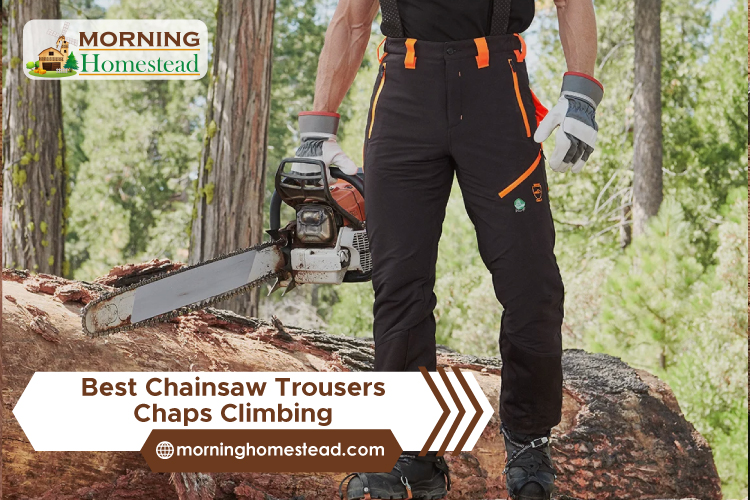Last Updated on June 8, 2023 by Georgie Smith
In occupations such as farming, landscaping, ground maintenance, and logging, professionals are at risk of serious injuries when handling chainsaw equipment. Power tool-related accidents are not only high, but the injuries are often more severe.
For utmost protection when handling chainsaws, professionals wear the required Personal Protective Equipment (PPE) to make their hard work safer. Chainsaw trousers are arguably one of the essential pieces of PPE for anyone operating a chainsaw. We discuss the advantages of chainsaw chaps and pants and give you a full guide and review of the best chainsaw trousers for climbing in this article.
Basic Comparison:
SSL
Storage
Domains
Sub-domains
Husqvarna 531309565
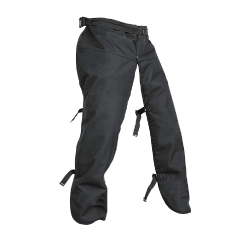
Easy to use
Color: Black
Adjustable Belt
Adjustable waist
Husqvarna 587160704
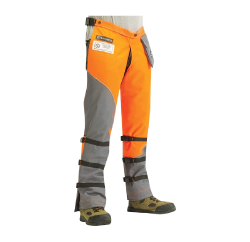
Easy to use
Adjustable waist
Delran buckles
Ul certified
Forester Chainsaw Apron
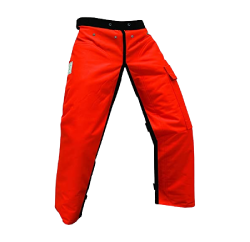
Color: Orange
Adjustable Belt
Apron Style
Chaps For Men
Benefits of Chainsaw Trousers
Even the most skilled in the craft is not exempt from accidents. A great pair of chainsaw trousers should offer adequate mobility and sufficient protection from accidental contact with a running chainsaw. Many homeowners underestimate the dangers of using a chainsaw and as a result, put themselves at risk for some hideous accidents.
Chainsaws trousers are made of sturdy and slippery fabrics to minimize injuries that may occur when one exposes the legs of an operator to a running chainsaw.
How Chainsaw Trousers Work?
Chainsaw chaps and pants are not cut-proof. However, the unique fabrics in the trousers entangle the teeth of the chainsaw, completely stopping it or slowing it down. This ability gives the operator time to switch off the machine in those critical seconds before the chainsaw rips into the skin.
In the event of a chainsaw accidentally hitting your leg, the inner layers of nylon, Kevlar or Polyester chainsaw protective trousers will instantly snag and bound the saw teeth. Depending on the fabric composition, some pants can entirely stop the chainsaw from running.
Not all chainsaw trousers are equal, and some are for specific tasks such as groundwork or tree climbing work. You might need them to be comfortable, lightweight, warm, long lasting, or waterproof depending on your preference.
Chainsaw Pants vs. Chaps
PPE for chainsaws typically consists of hard hats, face shields, safety glasses, ear protection, leg protection, and safety footwear. Leg protection comes in two forms: chainsaw pants or chainsaw chaps.
Chainsaw pants are optimal for climbers since they can put the pants on and leave them on fulltime. The design provides all-around protection for the front, back, and sides of the leg. They are more comfortable and don’t require adjusting or tweaking.
Chaps are worn over work clothes to cover the front of the legs. Chaps are faster to put on and get off, making them a favorite of workers who frequently drive trucks. They are also adjustable for workers to share, making them an economical choice. They are of water-repellent materials that don’t soak up rain and snow, leaving you dry and comfortable while at work.
| Pants | Chaps |
|---|---|
| Pros: – Goof for climbing trees and less likely to get caught on branches – Won‘t shift around as you work – All-around protection |
Pros: – You can take them off without changing pants – More relaxed to wear since they’re open in the back – Adjustable sizing allows sharing between crewmembers |
| Cons: – Can get hot, especially when worn for extended periods – More binding than chaps – Need a separate pair of pants to change into when done working |
Cons: – More likely to get snagged on branches or equipment – Buckles or straps may catch on the brush. – Less convenient for anyone who climbs trees |
Top 5 Best Chainsaw Trousers for Sale (Cheapest)
Chainsaw trousers are essential for all occasional and professional chainsaw users. We can look at the best chainsaw trousers for sale according to trusted Amazon reviews below. If you’re a little short on budget, these are great options for you.
Husqvarna 587160704 Technical Apron Wrap Chap, 36 to 38-Inch
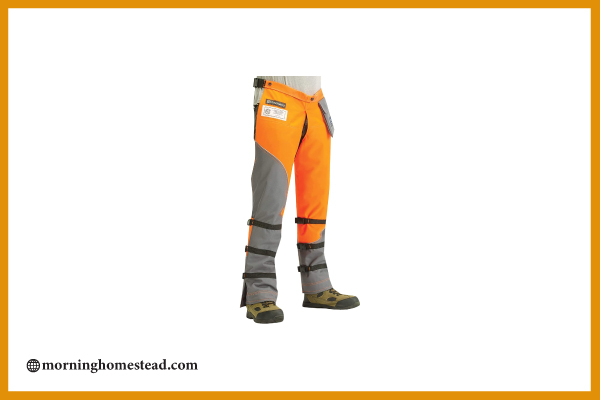
These Husqvarna Technical Apron Chaps are of PVC-coated denier polyester with Tek warp protective layers. These chaps will significantly reduce the severity and risk of injury while you’re wielding a running chainsaw.
Once in contact, the filler layers of fabric will clog the sprocket system of your electric chainsaw, slowing it down or stopping the chain entirely from rotating. The degree of subduing your saw depends on the following factors: the overall power of your chainsaw, length, chain type, and angle of contact. A more powerful chainsaw will be more difficult to slow down.
Husqvarna 587160704 has adjustable waist sizes, convenient pockets, acetyl Delran buckles, and can be washable in cold water.
Features:
Husqvarna 531309565 Chain Saw Apron Chaps, Gray/Blue

Known for chainsaw manufacturing, Husqvarna has some of the most efficient chaps on the market. Available in gray/blue color combinations, this pair of Husqvarna apron chaps come with UL certification while meeting the ASTM F1897 and ANSI Z133.1 standards.
These chaps have a 600-denier polyester outer shell with an additional 5-layer Kevmalimot material for superior protection. They can also fit users with different body types and sizes. The apron-style chaps are sure to protect the front of your legs, giving you some peace of mind when operating your chainsaw. When it comes to cleaning maintenance, hand wash, and hand dry only.
Features:
Forester Chainsaw Apron Chaps with Pocket, Orange
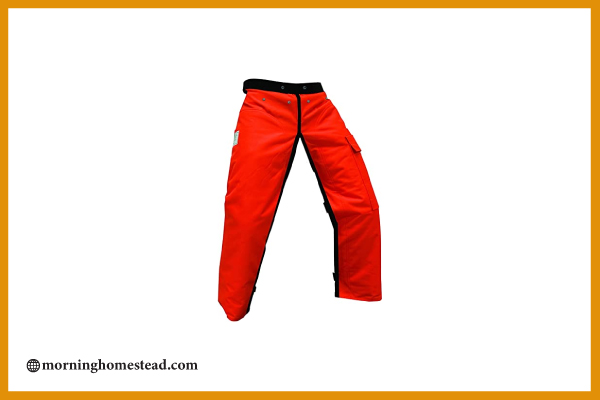
While they’re not as durable as the other chaps on this page, these Forester chaps offer a bit of protection at a low cost. They can still stop a chainsaw within contact. However, compared to the other brands, they’re less likely to end it as fast. There’s a fair chance that dropping a very high-throttle chainsaw on your leg could still result in a severe injury.
If you’re reasonably careful and meticulous, you can prevent any severe damage. In the event of a terrible mishap where your leg collides with a full-power chainsaw, the apron chaps can still arrest the chainsaw so you can turn it off before it cuts very deep.
This item is apron style which means the backs of your legs are left open. They come in 35” to 40″ sizes and have an external pocket for storing small items. They feel a bit flimsier than competing models, but they’re very bright and offer reflective strips for outdoor work.
Features:
Cons:
Husqvarna Technical Apron Wrap Chap, 40 to 42-Inch
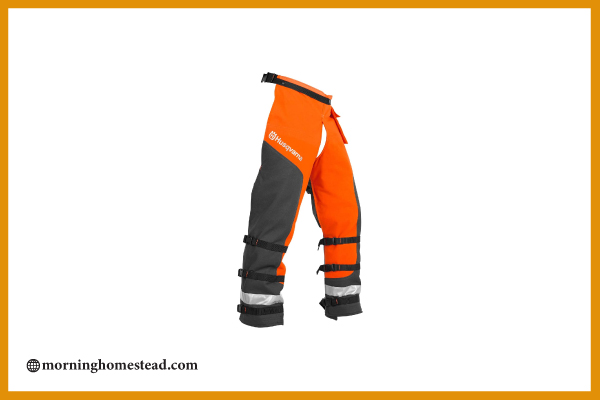
These Husqvarna Technical Apron Wrap Chaps are made of the same thick, quality materials as the 531309565 Chain Saw Apron Chaps and meet the same safety standards. The most significant difference is that these chaps wrap all the way around and ensure that you get protection from all angles.
So however you choose to swing a chainsaw, there will be a layer of protective fiber in your lower half to stop the blades from cutting you.
These Husqvarna chaps come in one adjustable size with handy pockets on the outside and extra-durable buckles to keep them in place while doing rigorous labor. You can also machine wash them in cold water and air-dry them instead of tumble-dry dry.
Features:
Cons:
Portwest Workwear Men’s Chainsaw Trousers

The Portwest Oak Chainsaw trousers are of Kevlar and reasonably heavy material designed for maximum safety. The Portwest Workwear range is ideal for extreme outdoor conditions with its thick, durable, and water-repellent composition. The design also incorporates stretch fabrics in critical areas for greater ease of movement.
The certified styles have nine layers of material to the front of each leg: 65 percent Polyester for protection and 35 percent Cotton 245g for comfort and breathability.
Features:
Features to Look for When Choosing Chainsaw Leg Protection
When looking for a pair of chainsaw chaps or pants, there are some crucial aspects you should keep in mind. Understanding the risks of the nature of work you’re in and how to alleviate those, can ensure you’re appropriately dressed and save you a bad buy.
So how can you tell if the chaps you are in the process of buying will provide the protection you need? When searching for the best chainsaw protective gear, inspect the following features:
1. Type of Chainsaw You Use
Chainsaw trousers are chainsaw specific. Consider the type of chainsaw you own (gas, electric, or cordless) and its running speed. The EU developed a rating scheme to classify trouser fabric for protection against cutting.
Chainsaw Fabric Classification:
| Class | Max Chain Speed |
|---|---|
| 0 | 16 meters per second (36 mph) (3150 feet per minute) |
| 1 | 20 meters per second (45 mph) (3937 feet per minute) |
| 2 | 24 meters per second (54 mph) (4724 feet per minute) |
| 3 | 28 meters per second (63 mph) (5512 feet per minute) |
For chainsaw leg protection, the lowest permissible level of security is Class 1, which resists cutting at 20 m/s.
You should be extra careful when buying protection for an electric chainsaw because some trousers are not built to withstand blows from electronic speeds. The few pants that can stop an electric chainsaw will cost more than regular ones.
2. Material:
The Chainsaw Protective EN381 Standards for PPE are:
- The item can resist a running chainsaw at speeds between 16 m/s and 32 m/s.
- The seams holding the products together have sufficient strength.
- The fabric will not shrink excessively when washed.
The most common materials for chainsaw trousers are Kevlar, Ballistic Nylon, and Polyester. Different materials will cost differently and offer varying degrees of protection. Maintenance of different materials is also a variety. Some elements are machine washable while others, like Kevlar, should only be hand washed.
The layering of material also plays an important role. The higher the denier or fabric thickness, the sturdier and thicker the fiber will be. For example, Ben Meadows offers chaps from 4 layers to 9 layers. The most popular tend to be 4-ply, 5-ply, and 6-ply.
3. Comfort:
The comfort of a person handling a dangerous power tool needs to be a high priority. Consider the factors below:
- Size – The size of this protective clothing should afford you enough room for movement. Harm may not always come from the running chainsaw. At times, you may need to run from falling trees and branches. Clothing and gear that obstruct your movement would cost you dearly in such situations.
- Weight – The weight of protective gear should be just manageable; not too heavy as to hinder movement and not too light to compromise quality.
- Breathability – Finally, breathable chaps make hot days bearable. If you plan to work in the summer, consider the breathability of chainsaw chaps.
4. Design:
When looking at aspects of design, consider your workplace and the work requirements. Will you need pockets to hold things? Will you need to share chaps with family members? Pockets are handy to store accessories and avoid losing them in the brushwood. Adjustability can also help save money as opposed to buying many pairs of trousers.
5. Certification:
The final and crucial aspect to consider is certification. Certification verifies that the product meets the right safety standards for hazardous labor. Below are five certifications you can look out for when canvassing pants and chaps.
- UL (Underwriters Laboratories) is a global certification company that inspects, tests, and, validates technical products.
- ASNI (American National Standards Institute) is a non-profit American institute that tests and certifies the quality of goods.
- ASTM (or the American Section of the International Association for Testing Materials) is a timeworn international organization that certifies the quality and standards of products.
- OSHA (Occupational Safety and Health Administration) certification under the Department of Labor assures you that the company making the chaps treats its workers fairly.
- USFS Specification by the US Forest Service (USFS) sets its specifications for the construction of protective chaps and pants.
Type A and C Chainsaw Trousers
There are two types of protective chainsaw trousers: Type A and Type C.
- Type A chainsaw trousers buffer injury for only the front of the legs. They go over work clothes as chaps or as plain trousers. Chainsaw handlers are generally working on the ground wearing Type A pants.
- Type C chainsaw trousers wrap all around the legs and are almost always put on alone and not over another garment. Arborists typically wear Type C chainsaw trousers, to provide them with protection when scaling trees and operating the saw in awkward positions. Training organizations insist on students wearing Type C protection.
Chainsaw PPE Requirements:
Health and Safety legislation generally recommends the following personal protective equipment and clothing when operating a chainsaw. Consult the local work-related health and safety agency in your jurisdiction to confirm which version applies to your workplace.
Eye Protection:
CAN/CSA Standard Z94.3-07 (R2014) requires safety glasses with side shields, safety goggles, and face shields to protect the face and eyes. A face shield alone is not adequate eye protection. Always wear goggles or glasses under guard.
Gloves:
Gloves and mitts protect the hands when sharpening the saw and handling undergrowth. Leather gloves with ballistic nylon reinforcement absorb a good deal of vibration from the chainsaw and offer a good grip for the hands.
Foot Protection:
Chainsaw operators should wear well-fitted, thick, safety work boots approved by the CAN/CSA Standard Z195-14 on protective footwear. Boots made of ballistic nylon offer the best cut protection from running chainsaws. Rubber soles are good for snow and wet weather while hobnail boots with cork soles or grip soles are suitable for rough terrain.
Head Protection:
Hard hats must pass standards like CSA Standard Z94.1-15 on Industrial Protective Headwear. Helmets of BS EN 397 or BS EN 14052 standard are only for groundwork. For tree-climbing operations, AFAG recommends a mountaineering-style helmet complying with BS EN 12492 regulations. Bright colors are preferable to promote visibility.
Hearing Protection:
Chainsaws generate high noise levels of up to 95 to 115 decibels. Hearing protection devices must meet standards like CSA Standard Z94.2-14: Hearing Protection Devices – Performance, Selection, Care, and Use.
Leg Protection Clothing:
Pants or chaps with sewn-in ballistic nylon pads offer more protection. Close-fitting clothing without dangling parts prevents accidental snagging.
Fall Protection:
Body belts, lanyards, and harnesses are fall protection equipment for arborists or climbers.
Inspecting Your Chainsaw Trousers for Damage
Over time, your protective chainsaw pants or chaps will suffer wear and tear. A short daily frequent inspection will help you decide when to replace your gear. Generally speaking, you should replace them when any of the following conditions exist:
- The outer shell has numerous holes and cuts. Holes allow bar oil to contaminate the protective padding. The oil acts as an adhesive to the fibers, reducing the effectiveness of protection.
- Sawdust and woodchips made their way inside the layers of the chaps.
- Incorrect repairs like patch jobs that stitched through the protective padding. Sewing through the pad holds back the fibers from moving, reducing their power to catch on the chainsaw teeth.
- Weaken chaps due to bleach and harsh detergents. High-pressure washing destroys the pad resulting in lower cut-through strength.
- The first layer of protective padding has a cut that is longer than 1 inch.
Frequently Asked Questions:
Q: How do I find my size of chainsaw chaps?
A: Manufacturers size chaps by the overall length from the belt loop to the bottom of the chap. Most chaps have adjustable waists so order your size by measuring the total distance needed.
To know the length you need, measure from your waist to the top of your foot. That is the length you need to provide full coverage and protection. You do not want a pair of chaps that is too long it becomes a tripping hazard or too short it leaving a portion of your legs exposed.
Q: Can I wash my chainsaw chaps?
A: Cleaning protective trousers after use and before storage will extend their useful life. During use, sweat and oil regularly penetrate the layer of the chainsaw protection. This dirt fuses the fibers that ensure the chainsaw protection and thus reduces the protective effect.
It is necessary to wash them correctly on a regular basis to maintain the trousers’ performance. Most chaps can be machine washed on gentle settings while only hand wash chaps are constructed with Kevlar on warm water. Do not machine wash or dry Kevlar Chainsaw chaps to preserve their flame-resistant properties and decrease wear and tear.
Q: Can I repair my chainsaw chaps/pants?
A: Your pants are highly unlikely to protect you if they have huge cuts. Discard them. If they have insignificant cuts on the outer layer and the protective layer is undisturbed, you can patch them with duct tape to prevent further ripping.
Final Thoughts
Each year emergency rooms treat thousands of chainsaw-caused injuries. These injuries are severe enough to require an average of 110 stitches per incident!
It is essential to keep your safety equipment in good working condition and always suit up with complete PPE as you head out into the field. Full-body chainsaw protection could be the only thing standing between you and the emergency room.
Regardless of your choice of chainsaw chaps or pants, always wear one or the other when working with a chainsaw. Each of the best chainsaw trousers for climbing has its advantages and costs around the same price. The most important thing is whatever you get, wear them!
We always love to hear from you! Don’t forget to post in the comment section below. If you know anyone who is in need of a quality product like the ones in this review, please show some care by sharing this post with them.

